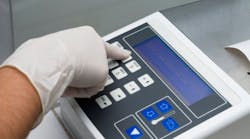Industry watchers expect steady growth ahead in the medical electronics market, as regulatory and political environments weigh heavy on makers of high-end equipment and systems and a desire for better wellness care spurs growth in low-end, consumer-oriented devices.
Recent studies predict roughly 6% compound annual growth in the global medical devices market over the next few years, as the aging population and an increase in critical illnesses such as cancer, heart disease, multiple sclerosis, lung disease and others spur demand for smarter and more sophisticated medical devices. But as designers and manufacturers navigate tough regulatory waters, especially in the United States, suppliers are watching distinct trends emerge among makers of high-end versus low-end products.
The time and effort involved in getting medical devices approved for use in some countries often makes it difficult for makers of next-generation, high-end equipment to get their products to market. Add to that growing concerns over higher corporate taxes and a political environment focused on stricter control of health care and you’ve got a recipe for slower development, at least domestically. On the other hand, demand for products and systems that promote wellness management—remote patient monitoring systems for use in clinical and non-clinical settings, for example—represent a big opportunity throughout the supply chain, as they both improve care and reduce costs.
“I see the major players moving forward in fits and starts [because] it’s so risky to develop and release next-generation high-end equipment. So many factors come into play,” says Nick Lukianov, director of business development for Avnet Electronics Marketing Americas. “But I don’t see that on the low end. From a wellness management perspective, there’s an awful lot of growth because that reduces costs significantly. The ability to monitor patients in their home or in a hospice environment offers huge cost advantages, so that’s where a lot of focus is lately.”
Lukianov and others point to growth in cosmetic therapies and aesthetic equipment such as laser skin treatments as industry drivers in North America as well. Advances in blood glucose monitoring equipment and insulin delivery for diabetes management are also keeping medical device makers busy.
Advancing Technology
The global medical devices market is expected to grow nearly 6% a year between 2011 and 2015, according to a recent study by market research firm TechNavio. The aging population worldwide and new construction of large-scale health care institutions are driving the trend. But, like Lukianov, the study also cites the variety of regulations for medical devices in different countries as potential challenges to market growth.
In a separate study, TechNavio points to growing demand for medical imaging equipment, such as X-rays, magnetic resonance imaging (MRI), and CT scan technology, due to a steep rise in the number of people suffering from critical illnesses worldwide and the desire to provide faster and better diagnosis.
Despite the challenges, the market’s steady growth is good news to many in the supply chain, such as electronics manufacturing service (EMS) provider SMTC Manufacturing Corp. Based in Toronto with additional operations in Southern California, Mexico, and China, SMTC makes products for customers in a range of industries, including industrial, wireless, and medical electronics, which represents about 5% of the company’s business.
SMTC executive vice president Paul Blom expects the medical electronics portion of the business to grow steadily over the next two years as original equipment manufacturers (OEMs) continue to outsource production to companies such as SMTC and as new companies emerge, bringing innovative technologies to the medical marketplace.
SMTC recently expanded its manufacturing facility in San Jose, Calif., to capitalize on the new opportunities. In particular, the expansion includes a new Class 10,000 clean room (a federal standard for clean room operation) that will serve growing demand from medical device OEMs seeking controlled environment capabilities for final assembly and packaging services. Joel Bustos, vice president and general manager of SMTC San Jose, calls the medical and wireless markets the fastest growing segments of the facility’s business today.
“These are exciting times for SMTC in San Jose, and with a new wave of innovation emerging in the valley we are seeing growing interest from OEMs looking to develop and manufacture these complex products right here in the heart of Silicon Valley,” Bustos explains.
Avnet’s Lukianov is seeing the outsourcing trend as well and points to the many small and large manufacturers that are farming out their design requirements to third-party original device manufacturers (ODMs), mainly because they have reduced their own engineering staffs. The trend is another key reason the medical device sector is poised for steady growth ahead.
“[Many of these companies] are going like gangbusters with a lot of the major manufacturers we’re familiar with,” says Lukianov.








